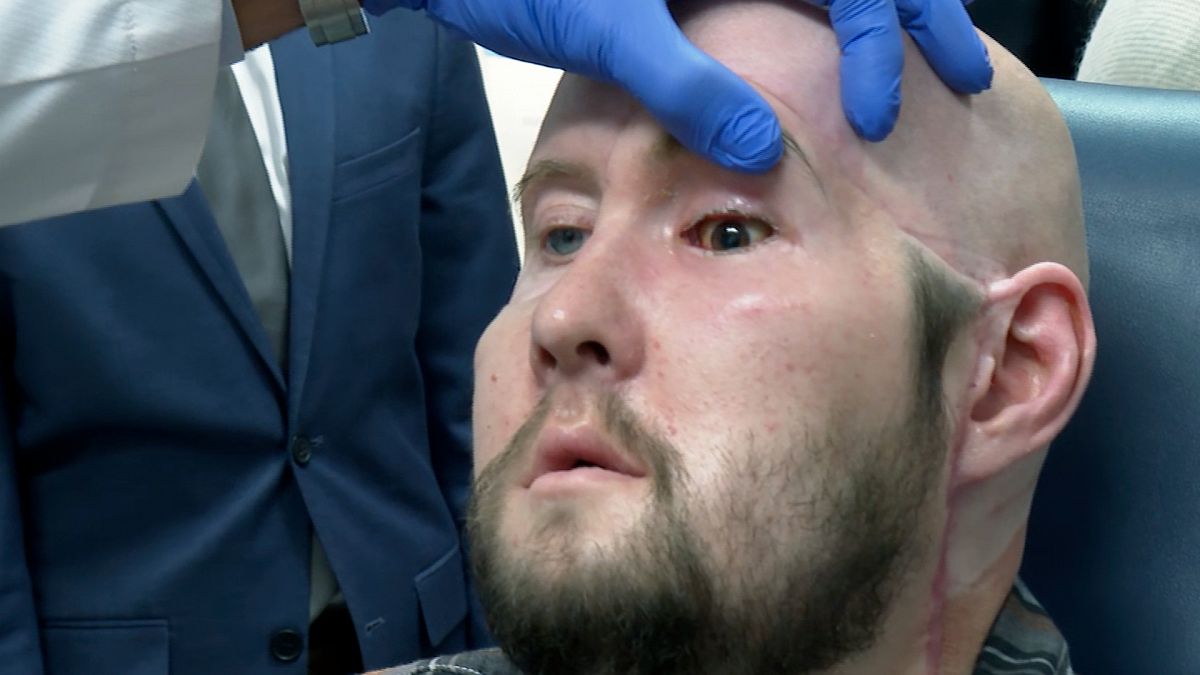Aaron James destroyed much of his face in an accident with high-voltage power lines but is now recovering well from a face and eye transplant.
US surgeons have successfully performed the world’s first transplant of an entire human eye although the doctors caution that it remains unknown if the patient, Aaron James, will ever be able to see with his new left eye.
Almost all of James’ face, including his left eye, was destroyed in an accident involving high-voltage power lines in June 2021.
The 46-year-old from Hot Springs, Arkansas, subsequently underwent a dual face and eye transplant in May, from which his doctors say he is recovering well noting that his new eye looks "remarkably healthy".
"It feels good. I still don’t have any movement in it yet. My eyelid, I can’t blink yet. But I’m getting sensation now," James said as doctors examined his progress recently.
The surgeons at NYU Langone Health had hoped that replacing James’ missing eye would yield better cosmetic results from a partial face transplant, by supporting a new eye socket and lid.
Transplants of the cornea, the clear tissue in front of the eye, are commonly performed to treat certain types of vision loss. But transplanting the whole eye, the eyeball, its blood supply, and the critical optic nerve that connects to the brain is a much more experimental procedure.
"We’re not claiming that we are going to restore sight," Dr Eduardo Rodriguez, the plastic surgery chief, who led the transplant, said
"But there’s no doubt in my mind we are one step closer," he added.
Fears the eye would shrivel like a raisin
Ahead of the surgery, specialists feared that post-transplant, the eye would shrivel like a raisin, but the results have been more satisfactory.
When Rodriguez propped open James’ left eyelid last month, the donated hazel-colored eye was as plump and full of fluid as his own blue eye.
Doctors have observed good blood flow and no sign of rejection so far.
Furthermore, researchers have begun analysing scans of James’ brain that detected some puzzling signals from that sight-giving but injured optic nerve.
One scientist who has long studied how to make eye transplants a reality called the surgery exciting.
Dr Jeffery Goldberg, chair of ophthalmology at Stanford University, called it “an amazing validation” of animal experiments that have kept transplanted eyes alive.
The hurdle is how to regrow the optic nerve, although animal studies are making strides, Goldberg added. He praised the NYU team’s “audacity” in even aiming for optic nerve repair and hopes the transplant will spur more research.
James, a military veteran, was working for a power line company when he was shocked by the live wire, ultimately losing his left arm in addition to his facial injuries.
His damaged left eye was so painful it had to be removed. Multiple reconstructive surgeries couldn’t repair extensive facial injuries including his missing nose and lips.
Face transplants remain rare and risky. James’ is only the 19th to have been carried out in the US and the fifth Rodriguez has performed. The eye experiment added even more complexity. But James figured he'd be no worse off if the donated eye failed.
"You’ve got to start somewhere, there’s got to be a first-person somewhere," said James.
"Maybe you’ll learn something from it that will help the next person," he added.
Three months after James was placed on the national transplant waiting list, a matching donor was found.
During the 21-hour operation, surgeons added an experiment twist: When they sliced together the donated optic nerve to what remained of James’ original, they injected special stem cells from the donor in hopes of spurring its repair.
Last month, tingles heralded healing facial nerves. Rodriguez gently pushed the closed eye and James felt the sensation, although on his nose rather than his eyelid.
Only time will tell if successful
The surgeon also detected subtle movements in muscles around the eye. How well the eye functions remains to be seen.
NYU Langone’s ophthalmologist, Dr. Vaidehi Dedania, ran a number of tests. She found expected damage in the light-sensing retina in the back of the eye.
But she said it appears to have enough special cells called photoreceptors to do the job of converting light to electrical signals, one step in creating vision.
Normally the optic nerve then would send those signals to the brain to be interpreted. James’ spliced-together optic nerve clearly isn’t healthy. Yet when light was flashed into the donated eye during an MRI, the scan recorded some brain activity, but in the wrong area.
That both excited and baffled researchers, though it may simply be a fluke, cautioned Dr. Steven Galetta, an eye-and-brain expert, and NYU Langone’s neurology chair.
Only time and more study may tell.
Still, the surgery marks a tremendous step forward according to Dr. David Klassen, chief medical officer of the United Network for Organ Sharing, which runs the nation’s transplant system.
For more on this story, watch the video in the media player above.



